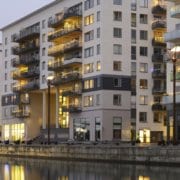3 Factors that Impact Office Occupancy Rates
An occupancy rate, the ratio of rented or used space to the total amount of available space, is an important metric for determining the success and desirability of a property. For investors these numbers can be used to determine a property’s anticipated cash flows, the financial health of a specific area, or whether or not a property is being properly managed.
Unfortunately, there is no perfect formula for ensuring that an office building’s occupancy rate does not spiral. In fact, real estate research firm Reis Inc. reported a 0.2% increase in office vacancy rates to 16.8% in Q2 2019 from that of Q2 2018 due to a slowing United States economy. However, there are certain factors that impact an office’s occupancy rates, including location, the current state of the market, and adaptability to future trends.
Desirability of the Location
The location of an office building can greatly determine both its actual and perceived value. An office location can be deemed desirable or undesirable based on factors such as the area’s crime rate, access to public transportation, proximity to downtown and popular entertainment areas, and so on. Therefore, it is crucial for CRE professionals to research the office’s current or potential location before developing or investing in the space.
Saturation in the Market
An oversupply of available office space can have a drastic impact on the occupancy of commercial office buildings. When supply outweighs demand, potential tenants take advantage of the market and often seek rents that are lower than normal. For sponsors who refuse to lower rent prices, market saturation can lead to significantly lower occupancy.
The co-working trend is one factor that contributes to the saturation in the office sector. Co-working facilities, which accounted for about 50% of office absorption in 2018, are expected to occupy anywhere from 20-30% of office inventory by 2023 at the current rate of expansion.
Adaptability to Future Workplace Trends
The commercial real estate industry has evolved significantly over the past few years due to the rise of CRE tech as well as the evolving needs and expectations of both tenants and investors. This evolution has impacted CRE’s office sector, as well as the other sectors, and has a significant influence on the workplace of the future. Gone are the days when an office’s appeal relied solely on its outside appearance or location. Today, details such as the functionality, interior design, and amenities of an office play a much larger role in tenant acquisition and retention, which directly impacts occupancy rates.
Multifunctionality
Multifunctionality is increasingly becoming an important strategy to improve occupancy rates. One method of creating multi-functionality within an office is to provide co-working opportunities. According to JLL, co-working spaces accounted for nearly 2/3 of U.S. office market occupancy gains in 2018.
Multifunctional offices maximize the building’s space and provide tenants with small and large open and enclosed rooms. For flexibility, many of the spaces within the office are designed so that they can be reconfigured and used in different ways and have easily moveable furniture.
With the workplace being the second largest expense for companies worldwide, tenants are seeking offices that will allow them to more effectively optimize and manage their buildings. Tenants are more likely to continue renewing their lease when they are effectively maximizing their office’s square footage and have very little underutilization of spaces within the office. Today, a multifunctional office can be used to attract and retain tenants and improve occupancy rates.
Interior Design and Layout
With 40% of employed Americans spending at least some time working remote, the interior design and layout of an office space has become increasingly in creating a place where employees will enjoy spending their time. Today, about 70% of offices have an open floor plan, which encourages innovation, creativity, and collaboration amongst employees. However, offices with private spaces throughout are also necessary for accommodating other work styles.
Choosing to have an eco-friendly office can also impact occupancy rates. In fact, green office buildings are reported to have higher occupancy rates and tenant satisfaction. Additionally, having natural light and plants inside the office can help improve occupancy rates.
Amenities
In the past, developers allocated about 2-4% of their portfolio space to amenities. Today, however, developers have increased the allocation of these spaces by 200%, enhancing the quality and variety of office amenities. As more and more companies seek ways to attract and retain talent, workplace amenities have become a top differentiator.
Workplaces with amenities such as ample parking spaces, on-site fitness facilities, outdoor seating, game rooms and loungers, and full-service food and beverage providers are amongst the most desirable amenities for attracting tenants and talent. The demand for amenities like these is largely driven by property managers’ need to develop and curate a memorable tenant experience, which improves tenant satisfaction and loyalty and aides them in competing more effectively within the market. When tenant needs are satisfied, they are more likely renew their lease. In addition, attractive facilities increase interest in office spaces, helping to keep higher occupancy rates afloat.
To learn more about occupancy/vacancy rates in commercial real estate asset classes, read 3 Methods to Reduce Multifamily Vacancy Rates.











